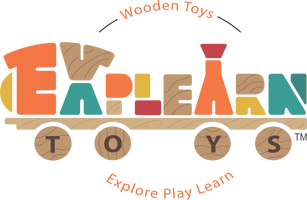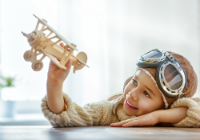Toys for young infants—birth through 6 months
Babies like to look at people—following them with their eyes. Typically, they prefer faces and bright colors. Babies can reach, be fascinated with what their hands and feet can do, lift their heads, turn their heads toward sounds, put things in their mouths, and much more!
Good toys for young infants:
- Things they can reach for, hold, suck on, shake, make noise with—rattles, large rings, squeeze toys, teething toys, soft dolls, textured balls, and vinyl and board books.
- Things to listen to—books with nursery rhymes and poems, and recordings of lullabies and simple songs.
- Things to look at—pictures of faces hung so baby can see them and unbreakable mirrors.
Toys for older infants—7 to 12 months
Older babies are movers—typically they go from rolling over and sitting, to scooting, bouncing, creeping, pulling themselves up, and standing. They understand their own names and other common words, can identify body parts, find hidden objects, and put things in and out of containers.
Good toys for older infants:
- Things to play pretend with—baby dolls, puppets, plastic and wood vehicles with wheels, and water toys.
- Things to drop and take out—plastic bowls, large beads, balls, and nesting toys.
- Things to build with—large soft blocks and wooden cubes.
- Things to use their large muscles with—large balls, push and pull toys, and low, soft things to crawl over.
Toys for 1-year-olds
One-year-olds are on the go! Typically they can walk steadily and even climb stairs. They enjoy stories, say their first words, and can play next to other children (but not yet with!). They like to experiment—but need adults to keep them safe.
Good toys for 1-year-olds:
- Board books with simple illustrations or photographs of real objects.
- Recordings with songs, rhymes, simple stories, and pictures.
- Things to create with—wide non-toxic, washable markers, crayons, and large paper.
- Things to pretend with—toy phones, dolls and doll beds, baby carriages and strollers, dress-up accessories (scarves, purses), puppets, stuffed toys, plastic animals, and plastic and wood “realistic” vehicles.
- Things to build with—cardboard and wood blocks (can be smaller than those used by infants—2 to 4 inches).
- Things for using their large and small muscles—puzzles, large pegboards, toys with parts that do things (dials, switches, knobs, lids), and large and small balls.
Toys for 2-year-olds (toddlers)
Toddlers are rapidly learning language and have some sense of danger. Nevertheless they do a lot of physical “testing”: jumping from heights, climbing, hanging by their arms, rolling, and rough-and-tumble play. They have good control of their hands and fingers and like to do things with small objects.
Good toys for 2-year-olds:
- Things for solving problems—wood puzzles (with 4 to 12 pieces), blocks that snap together, objects to sort (by size, shape, color, smell), and things with hooks, buttons, buckles, and snaps.
- Things for pretending and building—blocks, smaller (and sturdy) transportation toys, construction sets, child-sized furniture (kitchen sets, chairs, play food), dress-up clothes, dolls with accessories, puppets, and sand and water play toys.
- Things to create with—large non-toxic, washable crayons and markers, large paintbrushes and fingerpaint, large paper for drawing and painting, colored construction paper, toddler-sized scissors with blunt tips, chalkboard and large chalk, and rhythm instruments.
- Picture books with more details than books for younger children
- CD and DVD players with a variety of music (of course, phonograph players and cassette recorders work too!).
- Things for using their large and small muscles—large and small balls for kicking and throwing, ride-on equipment (but probably not tricycles until children are 3), tunnels, low climbers with soft material underneath, and pounding and hammering toys.
Toys for 3- to 6-year-olds (preschoolers and kindergarteners)
Preschoolers and kindergartners have longer attention spans than toddlers. Typically they talk a lot and ask a lot of questions. They like to experiment with things and with their still-emerging physical skills. They like to play with friends—and don’t like to lose! They can take turns—and sharing one toy by two or more children is often possible for older preschoolers and kindergarteners.
Good toys for 3- to 6-year-olds:
- Things for solving problems—puzzles (with 12 to 20+ pieces), blocks that snap together, collections and other smaller objects to sort by length, width, height, shape, color, smell, quantity, and other features—collections of plastic bottle caps, plastic bowls and lids, keys, shells, counting bears, small colored blocks.
- Things for pretending and building—many blocks for building complex structures, transportation toys, construction sets, child-sized furniture (“apartment” sets, play food), dress-up clothes, dolls with accessories, puppets and simple puppet theaters, and sand and water play toys.
- Things to create with—large and small crayons and markers, large and small paintbrushes and fingerpaint, large and small paper for drawing and painting, colored construction paper, preschooler-sized scissors, chalkboard and large and small chalk, modeling clay and playdough, modeling tools, paste, paper and cloth scraps for collage, and instruments—rhythm instruments and keyboards, xylophones, maracas, and tambourines.
- Picture books with even more words and more detailed pictures than toddler books.
- CD and DVD players with a variety of music (of course, phonograph players and cassette recorders work too!).
- Things for using their large and small muscles—large and small balls for kicking and throwing/catching, ride-on equipment including tricycles, tunnels, taller climbers with soft material underneath, wagons and wheelbarrows, plastic bats and balls, plastic bowling pins, targets and things to throw at them, and a workbench with a vise, hammer, nails, and saw.
- If a child has access to a computer: programs that are interactive (the child can do something) and that children can understand (the software uses graphics and spoken instruction, not just print), children can control the software’s pace and path, and children have opportunities to explore a variety of concepts on several levels.
Toy Safety
Safe toys for young children are well-made (with no sharp parts or splinters and do not pinch); painted with nontoxic, lead-free paint; shatter-proof; and easily cleaned.
It is important to remember that typical wear and tear can result in a once safe toy becoming hazardous. Adults should check toys frequently to make sure they are in good repair. For a list of toys that have been recalled by manufacturers, visit the Consumer Product Safety Commission website.



Leave a comment